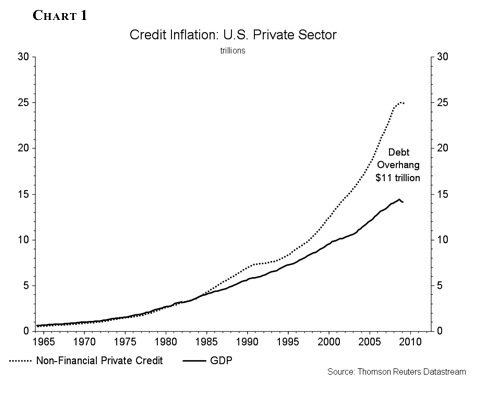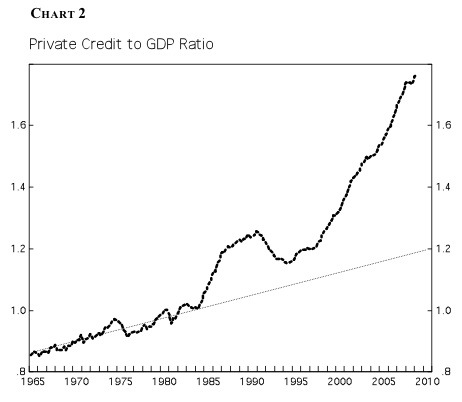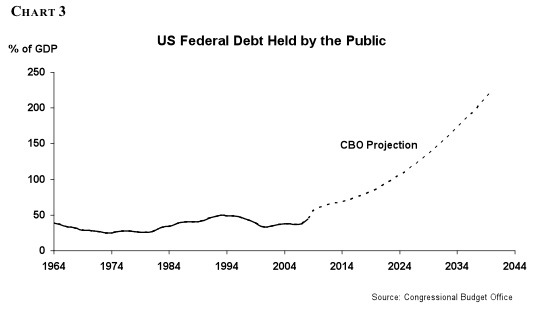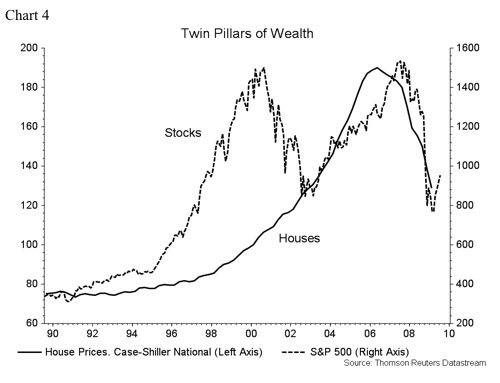| The Great Reflation Experiment |
| By John Mauldin |
Published
08/1/2009
|
Currency , Futures , Options , Stocks
|
Unrated
|
|
|
|
The Great Reflation Experiment
The question we have been focused on for some time now is whether we end up with inflation, or deflation, and what that endgame looks like. It is one of the most important questions an investor must ask today, and getting the answer right is critical. This week, we have a guest writer who takes on the topic of the great experiment the Fed is now waging, which he calls The Great Reflation Experiment.
By Tony Boeckh and Rob Boeckh
The Crash of 2008/9 should be seen as yet another consequence of long-term, persistent US inflationary policies. Inflation doesn't stand still. It tends to establish a self-reinforcing cycle that accelerates until the excesses in money and credit become so extreme that a correction is triggered. The bigger the inflation, the bigger the correction. Once a dependency on credit expansion is well established, correcting the underlying imbalances becomes extremely difficult. Reflation has occurred after each major correction, and this one is proving no exception. Return to discipline in the current environment would be too painful and dangerous. Once on the financial roller coaster, it is very hard to get off. Moreover, the oscillations between peaks and valleys become increasingly large and unstable.
Policymakers, money managers, and most forecasters have argued that the crash was a "black swan" event, meaning that it had an extremely low probability of occurrence. That is grossly misleading, as it implies that the crash was so far beyond the realm of normal probabilities that it was unreasonable to expect anyone to have foreseen it. That argument has been used to justify the widespread complacency that prevailed in the years leading up to the crash. Policymakers are still failing to recognize the systemic causes of the crash and seem to believe that enhanced regulation will prevent history from repeating. While it is true that regulators were asleep at the switch or looking the other way, they were not the cause.
The Debt Super Cycle
The real culprit is the US debt super cycle, which has operated for decades, mostly in a remarkably benign manner. The inflationary implications of the twin deficits (current account and fiscal), as well as the steady increase in private debt, have been moderated by the integration of emerging markets into the global economy. The massive increase in industrial output from China, India, and others has enabled persistent credit inflation in the US to occur with virtually no consequence to date (other than periodic asset price bubbles and shakeouts). How long the disinflationary impact of emerging-market productivity growth will persist and how long these nations will continue loading up on Treasuries, will be instrumental in determining the course that the Great Reflation will take.
Tougher regulation is surely appropriate, but it will not stop the next inflationary run-up unless the system is fixed. In the final analysis, newly minted money and credit must find a home somewhere.
Some Background on US Inflation
Inflation, to be properly understood, should be defined as a persistent expansion of money and credit that substantially exceeds the growth requirements of the economy. As a consequence of excessive monetary expansion, prices rise. Which prices go up and at what rate depends on a number of factors. Sometimes it is the prices of goods and services that are the most visible symptom of inflationary pressures. That was the case in the 1970s when the Consumer Price Index (CPI) hit a peak rate of 14% per annum. Sometimes it is the prices of assets such as homes, office buildings, stocks, or bonds that reflect the inflationary pressure, as we have seen in more recent years.
When inflation becomes pervasive, and other conditions are supportive, it can engulf a whole industry. We saw this in the financial sector in the period leading up to the crash. The supporting conditions or "displacements," to use the terminology of Professor Kindleberger, were financial innovation, deregulation, and obscene profits and salaries. These drew millions of bees to the honey. All great manias are accompanied by malfeasance, in this case the biggest Ponzi scheme in history and many other lesser ones. It is relatively easy to steal when prices are rising and greed is pervasive. Overspending and a general lack of prudence always become widespread when a mania infects the general public. Rational people can do incredibly stupid things collectively when there is mass hysteria.
The origins of post-war inflation go back to the late 1950s and early 1960s, though some would take it back much further. In the 1960s, the US dollar started to come under pressure as a result of US inflationary policy and foreign central banks' ebbing confidence in their large and growing dollar reserve holdings. The US responded with controls and government intervention in a number of areas: gold convertibility, the US Treasury bond market, the Interest Equalization Tax, and, ultimately, intervention on wages and prices. These moves clearly flagged to the world that external discipline would be subjugated to domestic employment and growth concerns. The policy was formalized when the US terminated the link between gold and the dollar in August 1971, essentially floating the dollar and setting the US on a course of sustained inflation. Of course, the dollar floated down, which, among other things, triggered the massive rise in general prices in the 1970s.
The next episode of credit inflation began in the 1980s, paradoxically triggered by the success of Paul Volcker's move to break the spiral of rising general price inflation through very tight money. He succeeded famously, and the CPI headed sharply lower along with interest rates, setting the stage for the massive US debt binge and the series of asset bubbles that followed. It was easy for the Federal Reserve to pursue expansionary credit policies while inflation and interest rates were falling.
The Great Reflation Experiment of 2009
Private sector credit, the flipside of debt, maintained a stable trend relative to GDP from 1964 to 1982 (Charts 1& 2). After that, the ratio of debt to GDP rose rapidly for the 25 years leading up to the crash, and is continuing to rise. The current reading has debt close to 180% of GDP, about double the level of the early 1980s. The magnitude and length of this rise is probably unprecedented in the history of the world. Even the credit inflation that was the prelude to the 1929 crash and the Great Depression only lasted five or six years.


Prior to government bailouts and stimulus, the panic, crash, and precipitous economic decline of 2008/9 were clearly on track to be much worse than the post-1929 experience. The pervasiveness of leverage - from banks to consumers to supposedly blue-chip companies - and the illusion of stability in the system, were fostered through the 25 years that this credit bubble has grown, basically uninterrupted. The speed and magnitude of the bailouts and stimulus - the end of which we won't see for a long time - aborted the meltdown. However, the story is far from over.
The Great Reflation Experiment ultimately has two components. The first is a rise in federal government deficits, debt, and contingent liabilities. The second is an expansion of the Federal Reserve's balance sheet. Both are unprecedented since World War II. US federal government debt is likely to reach close to 100% of GDP over the next 8 to10 years, according to the Congressional Budget Office (CBO) and supported by our own calculations (Chart 3). Anemic growth, falling tax revenue, increased government spending, and bailouts of indigent states, households, businesses, along with an aging population, will all undermine public finances to a degree never before seen in peacetime. According to CBO data, government debt could reach 300% of GDP by 2050 as contingent liabilities are converted into actual government expenditures. This massive peacetime deterioration in public finances will have grave consequences for living standards and asset markets, particularly in the longer run.

In the short run, huge deficits and growth in government debt are necessary. They will continue to play a crucial role in deleveraging the private sector and in helping to fill the black hole in the economy that has been caused by the sharp increase in household savings. Further out, government deficits will put upward pressure on interest rates. However, much of the economy, particularly housing and commercial real estate, is far too weak to absorb an interest-rate shock. Therefore, the Federal Reserve will have to monetize much of the rise in government debt, making it extremely difficult to unwind the explosion in the Fed's balance sheet and consequent rise in bank reserves - the fuel that could be used to ignite another money and credit explosion.
The bottom line is that the Fed is in a very difficult position. Its room to maneuver is either small or nonexistent, and the markets understand this. That is why there is a sharp divergence between those worried about price inflation and those fearing a lengthy depression.
Implications for Investors
Investors are also in an extraordinarily difficult predicament. From the peak in 2007, household wealth declined by about $14 trillion, over 20%, to the first quarter of 2009. Tens of millions of people had come to rely on rising house and stock prices to give them a standard of living that could not be attained from regular income alone (Chart 4). They stopped saving and borrowed aggressively and imprudently against their assets and future income, some to live better, some to speculate, and many to do both. That game is over.

Pensions have been devastated and people's appetite for risk has declined dramatically. The return on safe liquid assets ranges from 0.60% to 1.20%, depending on term and withdrawal penalties. Reasonable-quality bonds with a five-year maturity provide about 4%. Bonds with longer maturities have higher yields but are vulnerable to price erosion if inflationary expectations heat up. As for equities, people now understand that blue chip stocks carry huge risk. GE, once considered the ultimate "bullet-proof" stock, dropped 83% in the panic, and Citigroup lost 98%. Revelations of massive fraud schemes have further damaged trust and confidence in markets.
Against this backdrop we offer a few thoughts. First, an increase in price inflation as reflected in the CPI is a long way off. The degree of excess capacity in the world is probably the greatest since the 1930s, although excess capacity does get scrapped during recessions. Western economies will remain depressed for years, and China will also be important in keeping inflation down. Its capital investment is larger than the US's in absolute terms. It is currently 40% of GDP and growing at 30% per annum. Profit margins in China will probably get squeezed, which, together with the huge amount of underemployed labor, means that the Chinese will keep driving their export machine at full throttle, continuing to flood the world with high-quality, inexpensive goods. Therefore, investors who need income are probably safe holding reasonably high-quality bonds in the five-year maturity range. A bond ladder is a very useful tool for most people. Holdings are staggered over, say, a five-year time frame, and maturing bonds are invested back into five-year bonds, keeping the portfolio structure in the zero-to-five-year range. In this way, some protection against a future rise in price inflation and falling bond prices can be achieved.
Second, massive monetary stimulus is good for asset prices in the near term (e.g. stocks, bonds, houses, commodities) in a world of very weak price inflation and a soft economy. That is true as long as the economy does not fall apart again, which is very unlikely given all the stimulus present and more to come if needed. Therefore, investors who can afford a little risk should own some assets that will ultimately be beneficiaries of the wall of new money being created and thrown at the economy.
There is a major risk to our relative near-term optimism, and that is the US dollar. Foreign central banks hold $2.64 trillion, overwhelmingly the largest component of world reserves. The US role as the main reserve currency country is compromised by its persistent inflationary policies and current account deficits, a subject high on the agenda at the recent G-8 meeting in Italy and referred to frequently by China, Russia, Brazil, and others. Foreign central banks fear a large drop in the dollar, which would cause them potentially huge losses on their reserve holdings. They don't want more dollars, and yet they don't want to lose competitive advantage by seeing their currencies go up against the dollar. To preserve their competitive position, they have to buy more when the dollar is under pressure. On the other hand, since the 1930s the US has never subjugated domestic concerns to external discipline. Officials may talk of a strong-dollar policy, but their actions always speak differently. Their attitude towards foreign central banks is, "We didn't ask you to buy the dollars." The US has typically seen such buying as currency manipulation to gain an unfair trade advantage.
The most likely outcome is a nervous dollar stalemate or, as Lawrence Summers once described it, "a balance of financial terror." The most important central banks will continue to hold their noses and buy the dollar to keep it from falling too sharply. However, this is a fragile, unstable situation, and the dollar must fall over time. Investors need to diversify away from this risk. There are three obvious ways.
The first is investing in high-quality US equities that have a majority of their earnings and assets in hard-currency countries.
The second is investing in gold and related assets. Gold will probably remain in a tug of war for some time. On the negative side, it is faced with nonexistent global price inflation, even deflation, and a sharp decline in jewelry demand. On the positive side, concerns over U. monetary and fiscal debauchery will almost certainly heat up. As the odds of the latter increase, gold will be a major beneficiary, and investors should have a healthy insurance position in this asset class.
Third, most foreign currencies will also benefit from these fears, and hence investors can also protect themselves by diversifying into non-dollar assets in the best-managed countries. Some of these are emerging markets like China, which are liquid, in surplus, fiscally stable, and still growing well in spite of the global economic downturn. If and when the world economy begins to recover, and should price inflation stay low, asset bubbles are likely to recur. Where and when is always hard to tell in advance. Good prospects are in emerging-market equities, commodities, and commodity-oriented countries.
So, to sum up, in the next six to 12 months we look for a weak but recovering US economy, a continued deflationary price environment, pretty good asset and commodity markets, and continued narrowing of credit spreads. This view is based on the assumption that the new money created has to go somewhere, a stable to modestly falling dollar, and an anemic world economic recovery next year.
A buy and hold strategy has been bad advice for the past 10 years. The S&P is down 45% from its peak in early 2000. The investment world is likely to remain very unstable in the face of the difficult longer-run problems discussed above. Investors, whether they like it or not, are in the forecasting game, and forecasting is all about time lags. The exceptional circumstances of the current environment make any assessment of time lags extraordinarily difficult, and mistakes will continue to be costly. For that reason, holding well above average liquidity, in spite of the paltry returns, is sensible for most people whose pockets are not deep enough to absorb another hit to their net worth. They are in the unfortunate position of having to wait until the air clears a bit and more aggressive action can be taken with higher confidence. Warren Buffet has properly reminded us on numerous occasions that a price has to be paid for waiting for such a time, but then most of us aren't as rich as he is.
John Mauldin is president of Millennium Wave Advisors, LLC, a registered investment advisor. Contact John at John@FrontlineThoughts.com.
Disclaimer
John Mauldin is president of Millennium Wave Advisors, LLC, a registered investment advisor. All material presented herein is believed to be reliable but we cannot attest to its accuracy. Investment recommendations may change and readers are urged to check with their investment counselors before making any investment decisions.
|
|